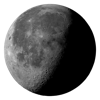» This article is also available in Italian.
Nova V462 in Lupus, an Astronomical Event not to be Missed
The appearance of a "nova" is one of the most interesting events for researchers and astronomy enthusiasts. Novae are relatively rare stellar explosions that can sometimes reach a brightness high enough to make their host star visible to the naked eye. Observing a nova is a unique opportunity to witness one of the most violent stellar events.
The Discovery of V462 Lupi
On June 12, 2025, the All-Sky Automated Survey for Supernovae (ASAS-SN), an automatic survey system for the discovery of supernovae, identified a new light source in the constellation of Lupus. Once the discovery was confirmed, the nova received the official designation of V462 Lupi.
Subsequent observations showed a rapid increase in brightness, which grew from a magnitude of about 22.3 before the explosion to a magnitude of 8.7 on the day of the discovery. The most recent observations, dated June 21, 2025, report a magnitude of 5.6, a brightness that is at the limit of visibility to the naked eye under skies without light pollution.
The following table summarizes the main information related to nova V462 Lupi, including the coordinates (J2000) for its localization:
| Name | V462 Lupi |
| Alternative designations | Nova Lupi 2025, AT 2025nlr, ASASSN-25cm |
| Coordinates (J2000) | |
| Right Ascension | 15h 08m 03.27s |
| Declination | –40° 08' 35.1" |
| Constellation | Lupus |
| Magnitudine (June 21, 2025) | 5.6 |
Sky charts useful for the identification
To facilitate the identification of the nova in the sky, a series of sky charts at various scales is presented below. The following chart has a field of view of approximately 50 degrees:
while the one below has a field of view of about 15 degrees:
The next image shows the position of the nova using high resolution photographic imagery from the Digitized Sky Survey. The field of view of this image is 1 degree. The image also reports the visual magnitude of a few stars nearby:

Visibility Conditions Depending on Latitude
The position of the nova, with a declination of about -40 degrees, favors observation from the Southern Hemisphere. It is however possible to observe it from the Northern Hemisphere as well, generally from latitudes lower than about 47° North. Above the latitude of 40° North, however, observations can be very difficult due to the low height above the horizon reached by the nova, even during its passage to the meridian. From these latitudes, a place with particularly dark sky and a completely unobstructed horizon to the south is necessary for a successful observation.
Nova V462 Lupi is not visible from
More Information
Constantly up to date information about the brightness of the Nova V462 Lupi are available at the database of the American Association of Variable Star Observers (AAVSO) at the following link: Photometric data of V462 Lupi (AAVSO).











